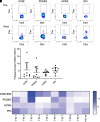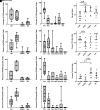Recognition of mRNA Splice Variant and Secretory Granule Epitopes by CD4+ T Cells in Type 1 Diabetes
- PMID: 36201618
- PMCID: PMC9797322
- DOI: 10.2337/db22-0191
Recognition of mRNA Splice Variant and Secretory Granule Epitopes by CD4+ T Cells in Type 1 Diabetes
Abstract
A recent discovery effort resulted in identification of novel splice variant and secretory granule antigens within the HLA class I peptidome of human islets and documentation of their recognition by CD8+ T cells from peripheral blood and human islets. In the current study, we applied a systematic discovery process to identify novel CD4+ T cell epitopes derived from these candidate antigens. We predicted 145 potential epitopes spanning unique splice junctions and within conventional secretory granule antigens and measured their in vitro binding to DRB1*04:01. We generated HLA class II tetramers for the 35 peptides with detectable binding and used these to assess immunogenicity and isolate T cell clones. Tetramers corresponding to peptides with verified immunogenicity were then used to label T cells specific for these putative epitopes in peripheral blood. T cells that recognize distinct epitopes derived from a cyclin I splice variant, neuroendocrine convertase 2, and urocortin-3 were detected at frequencies that were similar to those of an immunodominant proinsulin epitope. Cells specific for these novel epitopes predominantly exhibited a Th1-like surface phenotype. Among the three epitopes, responses to the cyclin I peptide exhibited a distinct memory profile. Responses to neuroendocrine convertase 2 were detected among pancreatic infiltrating T cells. These results further establish the contribution of unconventional antigens to the loss of tolerance in autoimmune diabetes.
© 2022 by the American Diabetes Association.
Figures





Similar articles
-
Peptides Derived From Insulin Granule Proteins Are Targeted by CD8+ T Cells Across MHC Class I Restrictions in Humans and NOD Mice.Diabetes. 2020 Dec;69(12):2678-2690. doi: 10.2337/db20-0013. Epub 2020 Sep 14. Diabetes. 2020. PMID: 32928873
-
Identification of promiscuous KIF20A long peptides bearing both CD4+ and CD8+ T-cell epitopes: KIF20A-specific CD4+ T-cell immunity in patients with malignant tumor.Clin Cancer Res. 2013 Aug 15;19(16):4508-20. doi: 10.1158/1078-0432.CCR-13-0197. Epub 2013 May 28. Clin Cancer Res. 2013. PMID: 23714729
-
Conventional and Neo-antigenic Peptides Presented by β Cells Are Targeted by Circulating Naïve CD8+ T Cells in Type 1 Diabetic and Healthy Donors.Cell Metab. 2018 Dec 4;28(6):946-960.e6. doi: 10.1016/j.cmet.2018.07.007. Epub 2018 Aug 2. Cell Metab. 2018. PMID: 30078552
-
Noncontiguous T cell epitopes in autoimmune diabetes: From mice to men and back again.J Biol Chem. 2021 Jul;297(1):100827. doi: 10.1016/j.jbc.2021.100827. Epub 2021 May 24. J Biol Chem. 2021. PMID: 34044020 Free PMC article. Review.
-
Translational mini-review series on type 1 diabetes: Systematic analysis of T cell epitopes in autoimmune diabetes.Clin Exp Immunol. 2007 Apr;148(1):1-16. doi: 10.1111/j.1365-2249.2006.03244.x. Clin Exp Immunol. 2007. PMID: 17349009 Free PMC article. Review.
Cited by
-
T cell and autoantibody recognition of nucleus-associated islet autoantigens in individuals with type 1 diabetes.Diabetologia. 2025 Aug;68(8):1721-1734. doi: 10.1007/s00125-025-06458-8. Epub 2025 Jun 9. Diabetologia. 2025. PMID: 40490584
-
The beta cell-immune cell interface in type 1 diabetes (T1D).Mol Metab. 2023 Dec;78:101809. doi: 10.1016/j.molmet.2023.101809. Epub 2023 Sep 20. Mol Metab. 2023. PMID: 37734713 Free PMC article. Review.
-
Using mass spectrometry to identify neoantigens in autoimmune diseases: The type 1 diabetes example.Semin Immunol. 2023 Mar;66:101730. doi: 10.1016/j.smim.2023.101730. Epub 2023 Feb 22. Semin Immunol. 2023. PMID: 36827760 Free PMC article. Review.
-
Islet autoimmunity in human type 1 diabetes: initiation and progression from the perspective of the beta cell.Diabetologia. 2023 Nov;66(11):1971-1982. doi: 10.1007/s00125-023-05970-z. Epub 2023 Jul 25. Diabetologia. 2023. PMID: 37488322 Free PMC article. Review.
References
Publication types
MeSH terms
Substances
Grants and funding
LinkOut - more resources
Full Text Sources
Medical
Molecular Biology Databases
Research Materials

